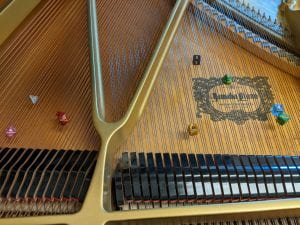Score:
- Acquire the following dice:
- 2 Four Sided Dice (2d4)
- 2 Eight Sided Dice (2d8)
- 4 Six Sided Dice (4d6)
- 1 Twenty Sided Dice (1d20)
- Gain access to a Baby Grand or Grand Piano
- Open the lid of the piano and prop it open
- Take the 2d8 and simultaneously roll them onto the strings of the piano
- Note the position of the leftmost d8
- Find the corresponding piano key that vibrates the strings the leftmost d8 lays upon
- Add the values of both d8
- Starting at the key we identified earlier, count up from that key a number of adjacent keys equal to the sum of both d8
- Keep note of these two keys
- Now take the 2d4 and simultaneously roll them onto the strings of the piano near the 2d8
- Note the value of each d4 and their proximity to the d8
- The value of the d4 provides the number of times (in a four note sequence) that each key is played
- The number of times each key is played is taken from the closest d4 to the d8 the key is connected to
- Now take the 4d6 and simultaneously roll them onto the strings of the piano
- Note the position of each d6 and their value
- Find the key corresponding to the position of each d6 upon the strings in the same manner as we did earlier with the d8
- These keys will also be played as the two earlier keys we determined are played, but can be played at any time
- The value of each d6 represents the number of adjacent keys, going either up or down, that can be alternatively played at any time
- Now take the 1d20 and roll it onto the strings of the piano
- Note the value of the d20 and multiply it by 10. This is the number of seconds you will play the piano for. Set a timer for this amount.
- With the correct starting keys identified, and the various values of dice rolled as well as their corresponding effects on how the piano is played in mind, prepare to play
- Start the timer and begin to play
- Stop playing when the timer finishes
- Observe the dice upon the strings of the piano. Repeat all above steps without rerolling any of the dice. Instead note how they have been agitated by your playing and have both new positions and values.
- With these new positions and values identified, prepare to play again
- Start the timer and begin to play
- Repeat ad infinitum
Artist’s Statement:
I was inspired by a number of existing historical musical works both in the form of experimental compositions and musical games. As a whole this section of music that inspired me is referred to as “Aleatoric Music” or “Indeterminate Music.” Music that has some element of its final product left up to chance. The first example of this can be found in the “Musikalisches Würfelspiel” (Musical Dice) which exploded in popularity during the Age of Enlightenment. This was during the “Classical Period” of Music from the mid 1700s to early 1800s and these games allowed even someone with barely any musical knowledge to roll dice and following the instructions of the game put together a new composition every time. Johann Kirnberger’s “The Ever-Ready Minuet and Polonaise Composer” (1757) is one such example, and Kirnberger himself was a student of J.S. Bach. Musical dice games can also be found in C.P.E. Bach’s “A method for making six bars of double counterpoint at the octave without knowing the rules” (1758) and Mozart’s “Instructions for the composition of as many waltzes as one desires with two dice, without understanding anything about music or composition” (1792). While the names of such games are quite overwrought, they serve as the main inspiration for this project. As the concept of using dice to inform various components of performance and provide musical limitations comes directly from these games. However, there are also other elements interacting. The idea of rolling the dice directly onto the strings so that they would interfere with the strings vibration and create a unique sound came from John Cage’s practice of creating “Prepared Pianos.” There was also inspiration from Terry Riley’s “In C” and Earle Brown’s “25 Pages.”
Documentation:
Video of Performance: https://photos.app.goo.gl/YJvM96vsuNFPDkb48

Before Playing

After Playing
